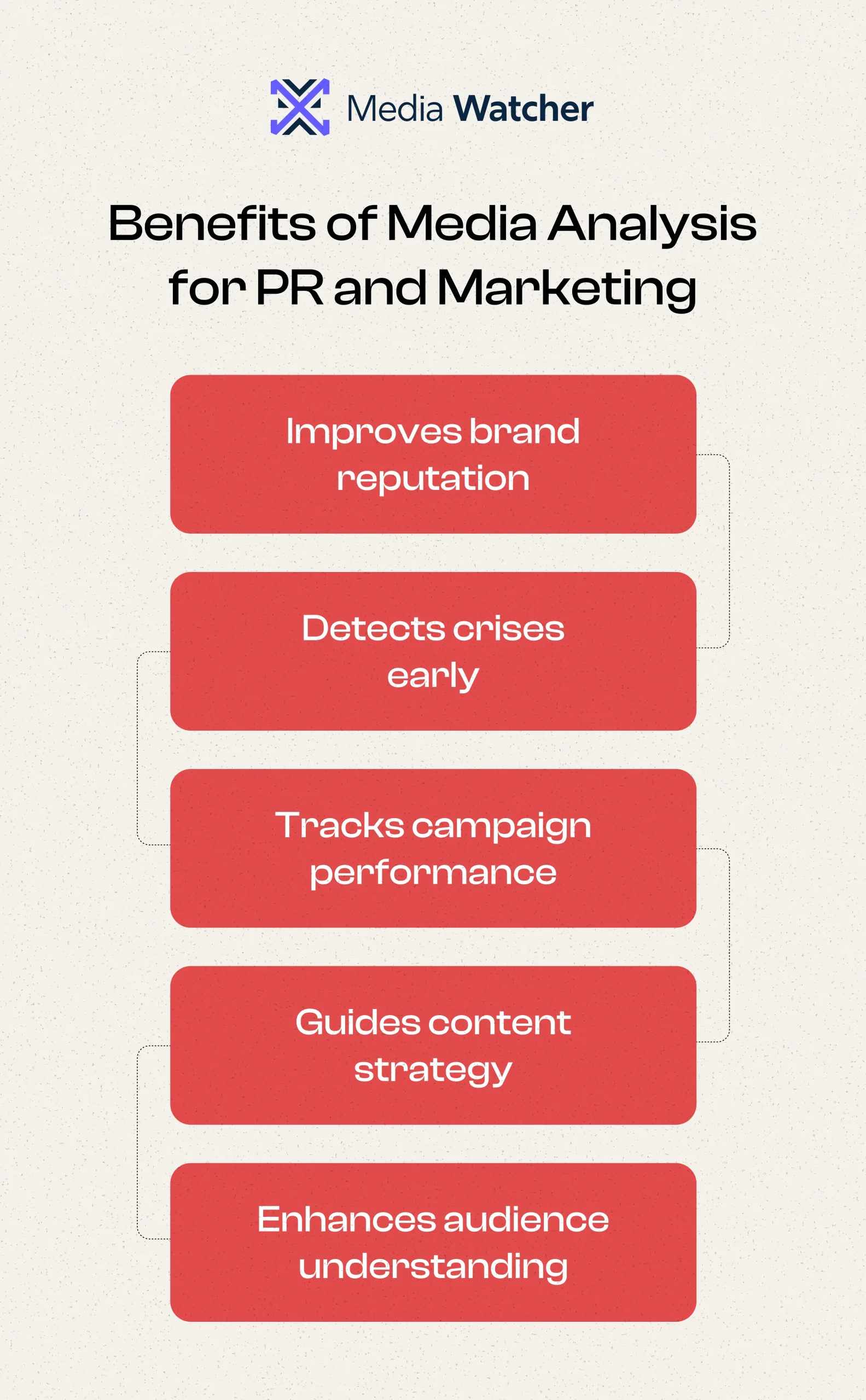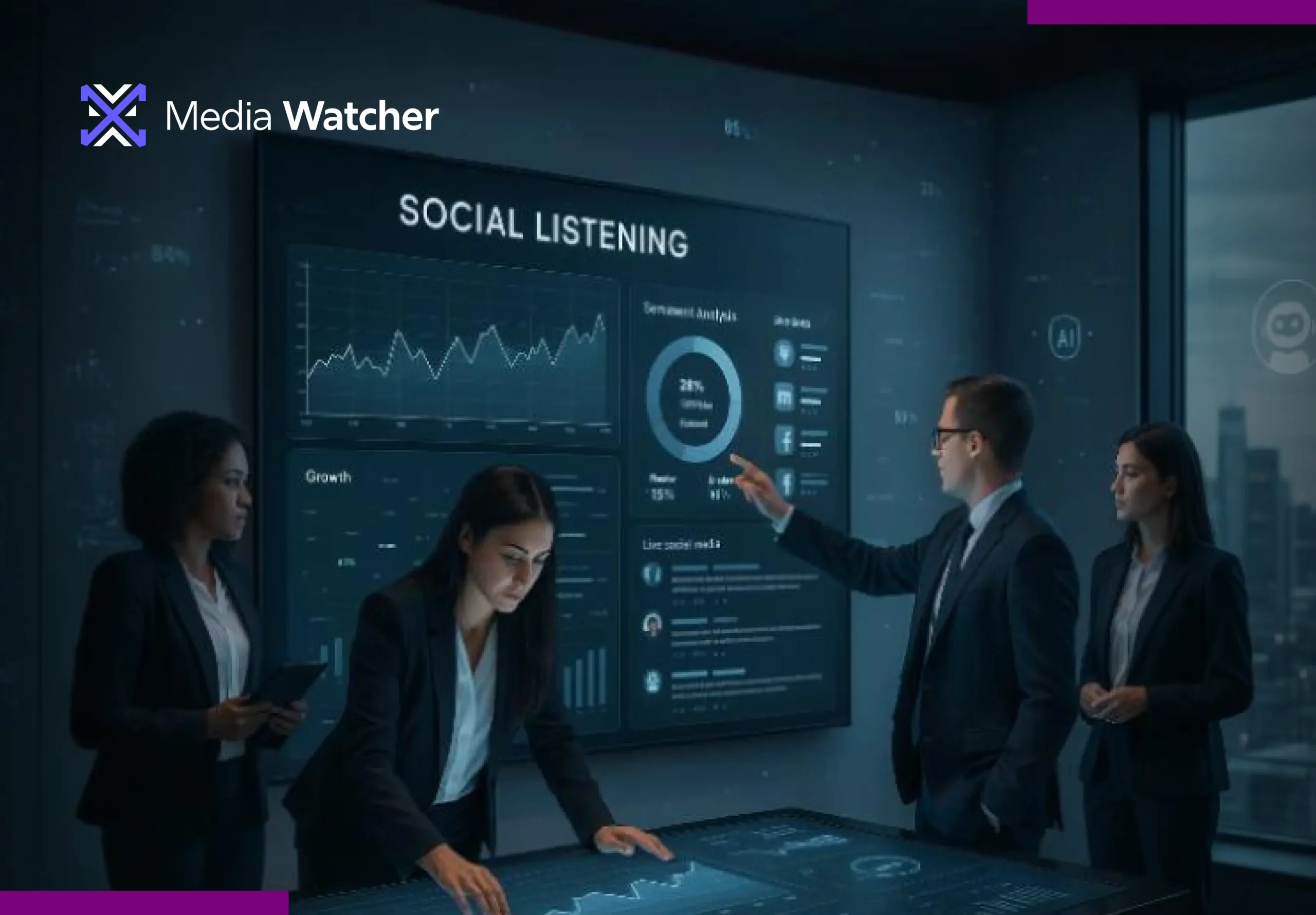Have you ever been curious about what fuels a conversation about your brand when there is no campaign going on?
It is the question that keeps every marketer and PR strategist on their toes, as influence nowadays does not only come in the form of ads, but also in the form of conversations. The digital age has turned word-of-mouth marketing into one of the most effective brand perception tactics, which can help with up to five times the sales generation compared to paid media.
However, to comprehensively grasp and control to exert such a right influence, brands need insight into what is being said, where, and by whom. It is at that point when media analysis is applied, where thousands of mentions, articles, and reactions are analyzed to create insights that show how the narratives propagate and how the audience actually feels.
What is Media Analysis?
As per the media analysis definition, it is the study and interpretation of digital content in news, social media, television, and other media to understand the influence that messages exert on the opinion of the people, trends in the market, and sentiments. It involves collecting and examining amounts of data, such as mentions, keywords, tone, and trends of engagement, to pinpoint the patterns, emerging stories, and how certain topics or brands are being portrayed. The study of media helps organizations to make informed choices, anticipate reputational threats, and discern opportunities before they turn into mass consciousness within a rapidly evolving information environment.
Let’s understand the media analysis example: take the case of financial analysts and their use of media analysis to determine trading signals. The other instance would be a renewable energy company that has found itself in an unexpected online debate and media attention due to a government announcement of policies that seek to encourage clean energy programs. The media intelligence tool would identify the spike immediately, analyze the sentiment, and point to a significant increase in positive perceptions of the sector, allowing the company to adjust its communication strategy to the rising optimism in the market.
This is how media analysis can transform the fragmented information into practical knowledge that fills the gap between the market behavior and the social discourse.
Types of Media Analysis That Assist with Market Research
There are two ways through which media analysis can help with PR and Marketing Success. Both methods are significant in explaining the impact of the media on the opinion of the masses, brand image, and behavior in the market. These two perspectives together provide a full picture of the scope and the content of media communication.
Quantitative Media Analysis
Quantitative media analysis refers to a data-driven process that quantifies and classifies the content of the media based on statistical and computational techniques. It assists in determining patterns such as the frequency of appearance of a topic, changes in sentiment over time, or where the public attention is distributed across regions or industries.
To illustrate, in financial markets, quantitative analysis would identify an abrupt increase in the number of conversations about a particular company or policy, indicating a potential trading opportunity.
On the same note, in a political campaign, researchers can study how often and how positively a candidate is mentioned to measure the exposure of the media and the impact on voters. This approach offers a factual basis for decision-making by transforming enormous media data into quantifiable insights.
Qualitative Media Analysis
Qualitative media analysis aims at interpreting the sense and context of media content. It looks at the way stories are presented, the feelings they create, and the motives of the communication. In the case of public relations and crisis management, qualitative analysis is used to consider whether an organization has been presented as accountable, defensive, or empathetic in the media.
It may explore how media narratives influence the discourse and social attitudes of the population in either journalism or policy research. The qualitative analysis can help better understand the feelings of the audience and help organizations design more impactful communication strategies through the knowledge of tone, language, and context.
How Media Analysis Software Works?
Below is an observable, practical overview of the manner in which one is likely to use media analysis software. The essence of the functionality of each step and what the software provides at each point is described, so it can be comprehensible in a better way:
1. Identifying the Purpose
This process starts by collecting data from various sources, including news websites, blogs, social media, and forums. The software constantly gathers real-time data to capture both trending conversations and long-term stories, making the media fully visible.
2. Locate Active Audience Channels
The data are then filtered and organized. Redundant entries are eliminated, and unrelated information is filtered out, and the software standardizes the information formats so that they can be analyzed properly. Every mention will carry metadata such as source, region, or topic to become more precise.
3. Sentiment and Context Analysis
The software is based on Natural Language Processing (NLP) to evaluate tone, emotion, and intent. It determines what is said as positive, negative, or neutral and examines the context of conversations. This assists in the determination of the audience perception towards brands, policies, or market events.
4. Trend and Topic Detection
The high-level algorithms monitor the volumes of conversation, the frequency of the keyword, and the topics being raised as time goes by. Unexpected spikes or changes in sentiment are identified as probable triggers, including early indications of crises, political events, or trading opportunities.
5. Visualization and Insights Generation
The results of the analysis are converted into interactive dashboards and visual reports. These images show trends, sentiment graphs, and geographic details, allowing users to simply interpret the findings and make evidence-based decisions in time.
6. Continuous Optimization and Reporting
The last phase is to generate automated summaries and reports for decision-makers. User feedback makes the system more accurate over time, and future analyses become more specific, relevant, and insightful.

How Businesses Can Get Maximum Benefits by Choosing the Right Media Analysis Services?
The lists of potential benefits that businesses can get from media content analysis are given below in detail for better comprehension:
Assess Frequency of New Campaign Launch
The analysis of modern media not only reports the happened events, but it also predicts the possible outcomes in the future. Through the analysis of the emerging topics, tone changes, and engagement strength, businesses are able to predict market trends or reactions of the people before they go mainstream.
This forecasting layer enables the strategic planning process to enable leaders to change tracks on a campaign, pricing, or message due to slight changes in sentiment that are normally difficult to detect with traditional analytics.
Assess Exposure to Public Conversation
In the present-day reality, reputational risks are transmitted faster than formal reaction. Media analysis is a live and panoramic look into the discussion of a brand in both digital and traditional media. In addition to simple surveillance, it recognizes the power of voices, the provenance of stories, and the speed of emotion. This can help organizations to preempt reputational damage before it is established and transform into prevention.
Map the Region
Global brands are in different cultural ecosystems, and what is celebrated in one region can backfire in another. The services of media analysis decipher local feeling, language particulars, and cultural sensitiveness, as well as ensure that communication plans are executed in line with the regional expectations. This cultural acumen facilitates more understanding and localized brand narratives, which enhance confidence in markets.
Ascertain Your Needs
There is an increasing dependence on insight, rather than instinct, by executives. Media analysis converts the cacophony of world discourse into organized intelligence, revealing stakeholder perceptions, policy implications, and media impact on consumer confidence. The outcome is more informed boardroom decision-making based on real-time evidence as opposed to retrospective data.
Evaluate the Solution on Certain Metrics
In addition to crisis alerts and sentiment tracking, media analysis assists in identifying needs and opportunities for innovation. Businesses can identify white spaces in the market by observing repetitive discussions, complaints, or new concerns. These lessons can be used to inform product creation, CSR programs, or marketing stories that fit the real audience’s needs instead of perceived trends.

How Media Watcher’s Media Analysis Tool Can Elevate Your Market Perception?
The question of how the world views your brand is not an option but a competition requirement. Media Watcher media analysis tools convert ad hoc media discussions into systematic intelligence and assist organizations in discovering how stories change and what moves the general audience. With real-time data and a sense of context, it allows brands to tighten positioning, build credibility, and be deeply authentic and authoritative.
This is the way Media Watcher pushes your perception in the market:
- Narrative Tracking: Track ongoing talks of how your brand and competitors are discussed in the various media channels around the world, and what story lines are influencing general understanding.
- Sentiment Intelligence: Evaluates the tone, emotion, and engagement patterns to reveal how the audiences respond to your brand and what factors change these reactions.
- Competitive Benchmarking: Compares your visibility, tone, and share of voice to those in the industry to display your relative position in the market.
- Influencer and Source Mapping: Identifies voices of influence and credible media sources that generate conversations that influence reputation and reach.
- Trend Forecasting: Identifies trends in audience behavior and market discussions, enabling brands to predict changes and adjust messages in advance.
Contact the Media Watcher team and book a free demo today!




